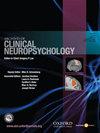A - 41 Relationship between Fear-Avoidance Behavior, Clinical Outcomes, and Recovery Time in Adults Following Concussion
IF 2.1
4区 心理学
Q2 PSYCHOLOGY
引用次数: 0
Abstract
To examine the relationship between fear-avoidance behavior, clinical outcomes, and recovery time in adults following concussion. This prospective study included patients aged 18–50 years who presented to a specialty clinic 5–30 days post-concussion. Participants completed a clinical intake (e.g., demographics/medical history), multidomain clinical assessment (Clinical Profile Screen [CP-Screen], Immediate Post-concussion Cognitive Testing [ImPACT], Vestibular/Ocular Motor Screen [VOMS], Patient Health Questionnaire-9 [PHQ-9], Generalized Anxiety Disorder-7 [GAD-7]), and the Fear-Avoidance Components Scale (FACS). Recovery time was ascertained at a subsequent visit(s). Fear-avoidant (FA) and non-fear-avoidant (NFA) groups were classified using cutoffs from the FACS (FA = 41–100; NFA = 0–40) and compared using independent samples t-tests, X2 tests, and analyses of covariance. Seventy-two participants (M = 28.7¬ ± 8.5 years, 69.4% female) were included: 37 (51.4%) in the FA and 35 (48.6%) in the NFA group. Groups did not differ on demographics, medical history, injury characteristics, or CP-Screen. A greater proportion of the FA group had the anxiety/mood profile (62.2% vs 31.4%, p < 0.01). The FA group had worse ImPACT reaction time (t(68) = −2.7, p < 0.01, d = −0.7), VOMS visual motion sensitivity (t(67) = −2.3, p = 0.03, d = −0.5), GAD-7 (t(70) = −3.9, p < 0.01, d = −0.9), and PHQ-9 (t(69) = −2.8, p < 0.01, d = −0.7) scores, and longer recovery (t(24) = −2.8, p = 0.01, d = −0.9), even when controlling for age and time to clinic (F[1, 22] = 4.6, p = 0.04, ηp2 = 0.17). Adults who reported high fear-avoidance (e.g., avoiding activity, catastrophizing) had worse clinical outcomes and longer recovery following concussion compared to non-fear-avoidant adults, despite no differences in demographics, medical history, injury characteristics, or symptoms. Clinicians should screen for and counsel adults post-concussion against engaging in fear-avoidance behaviors to improve recovery outcomes.A - 41 成人脑震荡后恐惧规避行为、临床结果和康复时间之间的关系
目的:研究成人脑震荡后恐惧回避行为、临床结果和恢复时间之间的关系。 这项前瞻性研究包括脑震荡后 5-30 天到专科门诊就诊的 18-50 岁患者。参与者完成了临床入组(如人口统计学/病史)、多领域临床评估(临床概况筛查 [CP-Screen]、脑震荡后即刻认知测试 [ImPACT]、前庭/眼球运动筛查 [VOMS]、患者健康问卷-9 [PHQ-9]、广泛性焦虑症-7 [GAD-7])和恐惧-回避成分量表 (FACS)。恢复时间在后续就诊时确定。恐惧回避组(FA)和非恐惧回避组(NFA)使用 FACS 的分界点进行分类(FA = 41-100;NFA = 0-40),并使用独立样本 t 检验、X2 检验和协方差分析进行比较。 72名参与者(中=28.7±8.5岁,69.4%为女性)被纳入其中:FA组37人(51.4%),NFA组35人(48.6%)。两组在人口统计学、病史、受伤特征或 CP-Screen 方面没有差异。有焦虑/情绪特征的 FA 组患者比例更高(62.2% vs 31.4%,P < 0.01)。FA组的ImPACT反应时间(t(68) = -2.7,p < 0.01,d = -0.7)、VOMS视觉运动敏感度(t(67) = -2.3,p = 0.03,d = -0.5)、GAD-7(t(70) = -3.9,p < 0.01,d = -0.9)和PHQ-9(t(70) = -3.9,p < 0.01,d = -0.9)更差。9)、PHQ-9(t(69) = -2.8,p < 0.01,d = -0.7)得分,恢复时间更长(t(24) = -2.8,p = 0.01,d = -0.9),即使控制了年龄和就诊时间(F[1, 22] = 4.6,p = 0.04,ηp2 = 0.17)。 尽管在人口统计学、病史、受伤特征或症状方面没有差异,但与不回避恐惧的成年人相比,报告高度回避恐惧(如回避活动、灾难化)的成年人在脑震荡后的临床结果更差,恢复时间更长。临床医生应该对脑震荡后的成年人进行筛查,并劝导他们不要做出回避恐惧的行为,以改善康复效果。
本文章由计算机程序翻译,如有差异,请以英文原文为准。
求助全文
约1分钟内获得全文
求助全文
来源期刊
CiteScore
4.60
自引率
7.70%
发文量
358
审稿时长
6-12 weeks
期刊介绍:
The journal publishes original contributions dealing with psychological aspects of the etiology, diagnosis, and treatment of disorders arising out of dysfunction of the central nervous system. Archives of Clinical Neuropsychology will also consider manuscripts involving the established principles of the profession of neuropsychology: (a) delivery and evaluation of services, (b) ethical and legal issues, and (c) approaches to education and training. Preference will be given to empirical reports and key reviews. Brief research reports, case studies, and commentaries on published articles (not exceeding two printed pages) will also be considered. At the discretion of the editor, rebuttals to commentaries may be invited. Occasional papers of a theoretical nature will be considered.

 求助内容:
求助内容: 应助结果提醒方式:
应助结果提醒方式:


